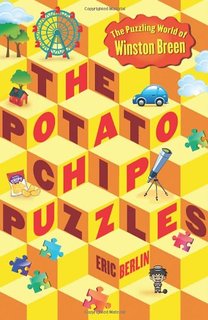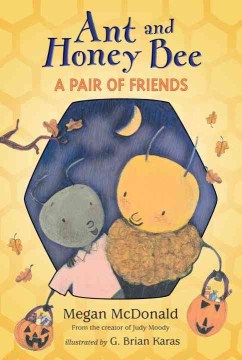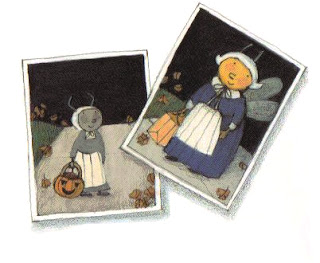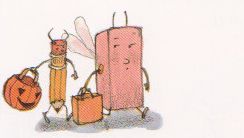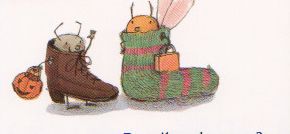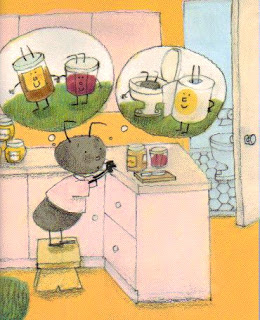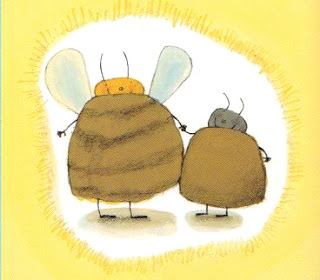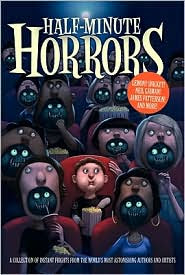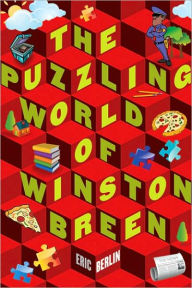 The Puzzling World of Winston Breen by Eric Berlin, a puzzlemaster who's work is often seen in the pages of the New York Times, is a very unique book indeed. On the surface, it's not too different from a Hardy Boys mystery, but just crack the spine and you'll see how special it is. Berlin has included eighteen puzzles (and their solutions) within the book, weaving them into the plot in many different ways. By my best guess, I think that a 10 year old child with a bit of experience at puzzling can work these out alone. Younger children or those without puzzling experience will most likely need help from an adult. I know I did. The puzzles range from pattern puzzles (wrapping paper and pizza toppings) to number puzzles (1111121 - turn this sequence of numbers into a correct equation using any math symbols you like) and, of course, word puzzles. There are word scrambles, word finds and a couple of variations on crossword puzzles. Some of the puzzles are made up by Winston and his friends, some are given to him by his math teacher, a curio shop owner and Winston's college-age cousin, as well as the puzzles that are part of the mystery in the book. The puzzles can be solved by writing in the book, but Mr Berlin has graciously included downloads of the puzzles from both books on his website so kids (and adults) can work them outside of the book. Click here for the downloads. I could not help thinking of Ellen Raskin's Newbery winner and childhood favorite of mine, The Westing Game, but with less detailed characters and more detailed puzzles! There's no one like Sydelle Pulaski in this book, but Berlin's puzzles out puzzle Sam Westing's any day. Main character Winston Breen is a master puzzle solver (and creator) and it is this skill that ultimately proves dangerous for him and his family.
The Puzzling World of Winston Breen by Eric Berlin, a puzzlemaster who's work is often seen in the pages of the New York Times, is a very unique book indeed. On the surface, it's not too different from a Hardy Boys mystery, but just crack the spine and you'll see how special it is. Berlin has included eighteen puzzles (and their solutions) within the book, weaving them into the plot in many different ways. By my best guess, I think that a 10 year old child with a bit of experience at puzzling can work these out alone. Younger children or those without puzzling experience will most likely need help from an adult. I know I did. The puzzles range from pattern puzzles (wrapping paper and pizza toppings) to number puzzles (1111121 - turn this sequence of numbers into a correct equation using any math symbols you like) and, of course, word puzzles. There are word scrambles, word finds and a couple of variations on crossword puzzles. Some of the puzzles are made up by Winston and his friends, some are given to him by his math teacher, a curio shop owner and Winston's college-age cousin, as well as the puzzles that are part of the mystery in the book. The puzzles can be solved by writing in the book, but Mr Berlin has graciously included downloads of the puzzles from both books on his website so kids (and adults) can work them outside of the book. Click here for the downloads. I could not help thinking of Ellen Raskin's Newbery winner and childhood favorite of mine, The Westing Game, but with less detailed characters and more detailed puzzles! There's no one like Sydelle Pulaski in this book, but Berlin's puzzles out puzzle Sam Westing's any day. Main character Winston Breen is a master puzzle solver (and creator) and it is this skill that ultimately proves dangerous for him and his family.
Set in the charming, planned community of Glenville - there is a map at the start of the book - the characters experience a sense of freedom that is a bit of a throwback to the 1950s but also completely necessary in most kid's books, a mystery especially. The story begins with the tenth birthday of Katie, Winston's little sister. Winston has given her a carved wooden box that he bought at Penrose's Curio Shop in town. Winston loves walking up and down the aisles of the store which are filled with antiques and remnants from estate sales, but he loves swapping puzzles with Mr Penrose even more. Starting with word searches as a six year old, the progressing on to crossword puzzles and other mind benders, Winston sees puzzles (and solves puzzles) in everything, even the patter on a piece of wrapping paper. When Katie discovers that the box, which came from the estate of Livia Fredericks, the elderly daughter of Walter Fredericks, founder and planner of Glenville, has a false bottom, the mystery begins. Four pieces of wood with words engraved on them prove to be the start of a treasure hunt that turns dangerous pretty quickly.
As the story unfolds, Winston, Mal, Jake and Katie learn that Mrs Lewis, the town librarian, is the last living descendant of Walter Fredericks, a puzzle lover who left behind one last puzzle that he hoped would bring his four squabbling children together after his death - which was over 25 years ago. Mrs Lewis is also in possession of four puzzle pieces but, after being harassed by treasure hunters and an unknown burglar who is making threatening phone calls, the sight of Winston and his (and Katie's) puzzle pieces sends her over the edge. This outburst also brings two other treasure hunters out of the woodwork. The two remaining sets of puzzle pieces are now in the possession of David North and Mickey Glowacka, both unsavory in their own ways, and each man approaches Winston separately about combining resources and working together on the puzzle before Winston even knows that the pieces are clues to a hidden treasure. Once she has calmed down, Mrs Lewis and her neighbor Ray Marietta, a retired police officer who is very protective of Mrs Lewis, meet with Winston to explain the history of the pieces and share their plan for working together, all four holders of the clues, to solve the mystery.
Hoping they can get to the bottom of the puzzle in one day, the group meets at the library and quickly begins to solve the puzzle, Winston doing the bulk of the work. The first set of clues leaves to another set, which is in the possession of Mr Rosetti, long time proprietor of the sole pizza parlor in Glenville. This set of clues leads to another long time resident of Glenville, but this is where steam runs out for the group. The next holder of the third set of clues only has three envelopes to pass on and three is not enough to lead to the location of the treasure. Deflated and defeated, Winston and Katie return home to join their mother for dinner. However, things take a serious turn when people involved with the treasure hunt turn out to be not quite who they say they are and they take Winston hostage in an attempt to get the treasure for themselves. The climax is heart stopping at times and wholly believable and the resolution to the mystery is satisfying.
The puzzles in the book are spaced evenly throughout the story and represent a wide range of challenges, from word based puzzles to number puzzles to pattern puzzles and even a few riddles here and there. I think that the love of puzzles is most often passed from parent to child. My husband grew up in a household where his mother and grandmother did the Sunday (which is the hardest) New York Times crossword puzzle in ink, calling each other occasionally when they needed help with a clue. Subsequently, my husband and his sister love crosswords and even the occasional sudoku or ken ken. Inspired, I give the Monday and Tuesday NYTimes puzzles a crack when I have the free time, but Wednesday is always a struggle for me. My daughter and son, however, will try any puzzle - word or number - and I hope they keeps this up. Whether a child is a puzzle lover or not, The Puzzling World of Winston Breen is a plain old great mystery. But, this book is also a wonderful opportunity to engage with your child as s/he comes upon the puzzles in the story and try to work them out together. Puzzling is always more fun when someone is working right alongside you!
Don't miss books 2 & 3, also in paperback!
Readers who enjoyed this book might also like these books, all of which have been reviewed here:
The Brixton Bothers Series by Mac Barnett
The Enola Holmes Series by Nancy Springer
Shakespeare's Secret by Elise Broach
Blue Balliet's Art Mystery Books
and, of course, The Westing Game!

